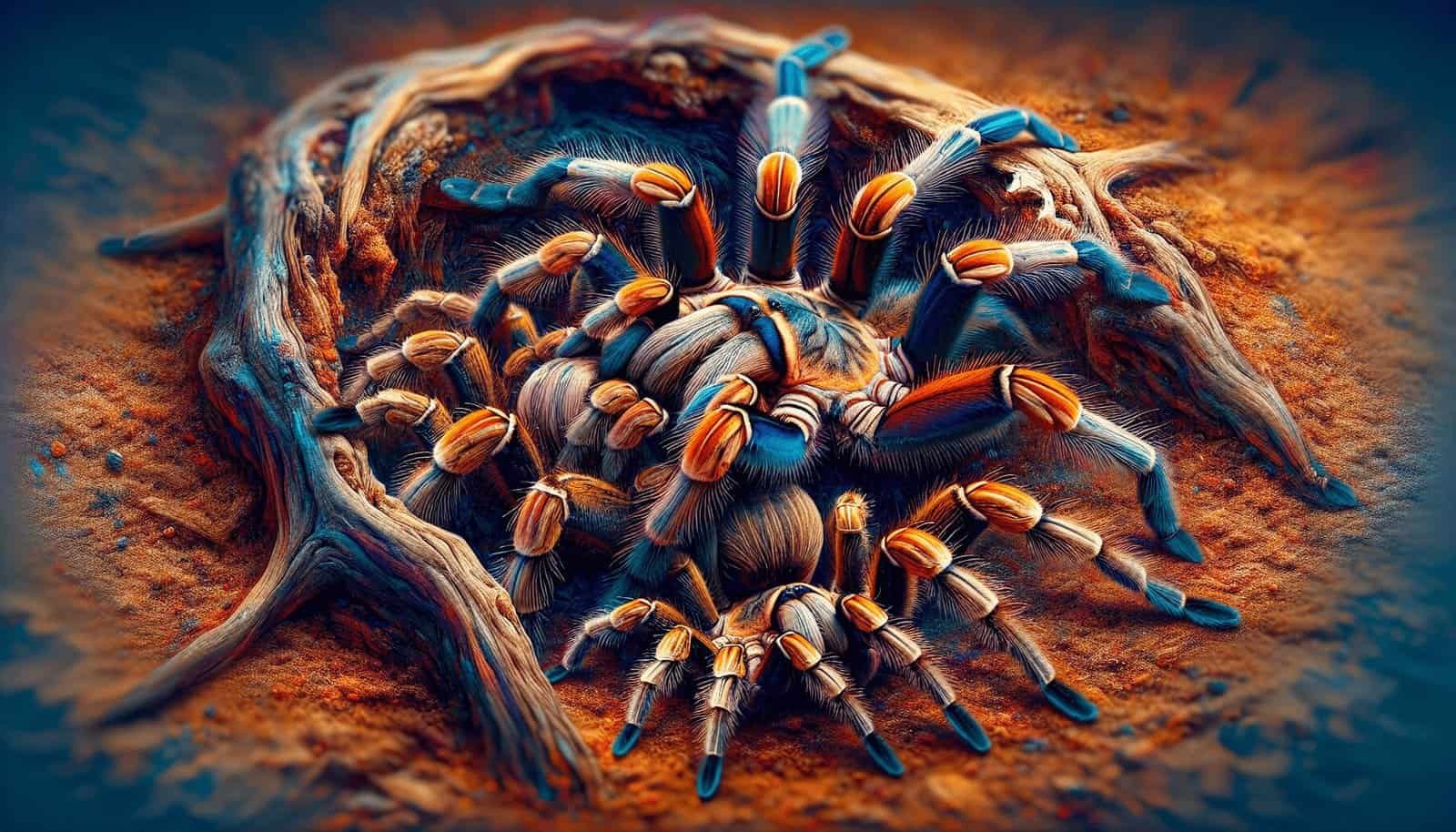So you’ve decided to delve into the fascinating world of tarantula breeding and are now wondering how to ensure the safety of both male and female tarantulas during their intimate encounter. Well, fear not! In this article, we will explore some essential tips and guidelines to help you create a safe and comfortable environment for these creepy crawlers to mate without any harm or stress. From adjusting the enclosure conditions to choosing the right partners, we’ve got you covered on all you need to know to ensure a successful and safe tarantula mating experience. Let’s dive in!

Understanding the Mating Process of Tarantulas
A brief overview of tarantula mating behavior
Tarantulas, fascinating creatures of the arachnid family, have a unique mating process. Unlike many other species, female tarantulas are generally larger and more dominant than males. This dynamic plays a crucial role in their mating behavior. Male tarantulas must approach the female with caution and convince her that they are a suitable mate.
The importance of safety during tarantula mating
Safety is paramount when it comes to tarantula mating. Both the male and female can be susceptible to injuries and stress during this delicate process. To ensure the well-being of both partners, it is essential to create a suitable environment, closely monitor their behavior, and provide necessary intervention if aggression or fear arises.
Common risks and challenges during mating
Mating for tarantulas can be challenging due to various risks and obstacles. These may include premature or forced mating attempts, aggression between the partners, and potential injuries. Understanding these challenges and knowing how to address them is crucial for a successful and safe mating process.
Preparation: Health and Environmental Factors
Ensuring the general health of mating tarantulas
Before attempting mating, it is crucial to ensure the general health of both the male and female tarantulas. Regular inspections for signs of illness or injury, such as abnormalities in their appearance or behavior, should be carried out. If any concerns are detected, it is advisable to consult with a veterinarian specializing in arachnids.
Proper housing and environmental conditions for mating
Creating a suitable environment for mating is vital for the safety and comfort of the tarantulas. Adequate housing should be provided, ensuring it is spacious enough to accommodate both partners comfortably. The enclosure should mimic their natural habitat, with proper temperature, humidity, and substrate. It is essential to research the specific requirements of the particular species of tarantulas involved.
Providing sufficient space and hiding spots
Tarantulas appreciate having ample space and hiding spots during the mating process. Each tarantula should have its own space within the enclosure to retreat, reducing the chances of aggressive behavior or stress. Adding various natural elements, such as hollow logs or small burrows, can provide suitable hiding spots for both male and female tarantulas.

Physical Examination and Behavior Observation
Determining the readiness of the male and female
Before attempting to mate tarantulas, it is important to assess the readiness of both partners. This can be determined by examining their physical condition, checking for signs of sexual maturity, and observing their behavior. Adult males should have mature pedipalps, while females should display receptiveness and the absence of molting behavior.
Checking for signs of illness or injury
Before allowing the tarantulas to mate, a thorough physical examination should be conducted to ensure they are free from any health issues. This includes checking for external injuries, abnormalities in their body structure, and any signs of illness. If any concerns are identified, it is best to postpone mating until the tarantulas have received proper veterinary care.
Monitoring mating behavior and receptiveness
Observing the behavior and receptiveness of both male and female tarantulas is crucial during the mating process. The male should display courtship behaviors, such as leg waving or drumming, to indicate his intentions. The female, on the other hand, may show receptiveness by lifting her abdomen or remaining motionless. Monitoring these behaviors helps ensure that the timing is ideal for a successful mating.
Separate Enclosures for Male and Female
Advantages of separate enclosures
Keeping the male and female tarantulas in separate enclosures until they are ready to mate offers several advantages. It minimizes the risk of premature or forced mating attempts, which can cause stress and injury to both partners. It also allows for better monitoring of their behavior, ensuring their safety during the entire mating process.
Preventing premature or forced mating attempts
Male tarantulas are known for their persistence and eagerness to mate, often leading to premature or forced mating attempts. By keeping them in separate enclosures, the female can maintain her dominance and choose whether or not she wants to mate. This reduces the risk of aggression and ensures a more controlled and consensual mating process.
Creating suitable conditions for pairing
When the time is deemed appropriate for mating, the male and female tarantulas can be gradually introduced in a suitable environment. This can be done by placing their enclosures near each other, allowing them to sense each other’s presence through visual and olfactory cues. This gradual introduction helps reduce stress and increases the chances of successful mating.

Introducing Mating Partners
Gradual introduction through visual and olfactory cues
To ensure a smooth introduction between male and female tarantulas, it is advisable to use gradual exposure to visual and olfactory cues. This can be achieved by placing their enclosures close to each other, allowing them to see and smell one another without direct physical contact. This helps the mating partners become familiar with each other before any intimate interactions take place.
Using barriers or a clear divider initially
During the initial phases of introduction, it can be helpful to use barriers or a clear divider between the male and female enclosures. This provides an added layer of safety and prevents any potential aggressive behavior from escalating. The barrier should be transparent, allowing both partners to see and interact with each other without direct physical contact.
Monitoring initial interactions and reactions
Once the male and female tarantulas have been introduced in a controlled environment, it is crucial to closely monitor their initial interactions and reactions. Take note of their body language and behavior, ensuring there are no signs of aggression, fear, or stress. Intervene immediately if necessary to prevent any potential harm to either tarantula.
Ensuring Proper Safety during Mating
Avoiding aggression and predation
During the mating process, it is essential to create an environment that minimizes the chances of aggression and predation between the male and female. Providing ample hiding spots and ensuring a relaxed atmosphere can help reduce stress and encourage successful mating. Avoid disturbing the tarantulas unnecessarily, as this can lead to defensive or aggressive behavior.
Recognizing signs of aggression or fear
Even with careful preparation, there is still a possibility of aggression or fear arising during tarantula mating. It is important to recognize the signs, which may include hissing, fang displays, or physical aggression. If such behavior is observed, it is advisable to interrupt or separate the mating partners to prevent injuries.
Interrupting or separating if necessary
If aggression or physical harm is evident during the mating process, it becomes essential to intervene to ensure the safety of both tarantulas. This can be done by gently separating the mating partners using a soft brush or other non-threatening tool. After separating, observe their behavior and decide whether to proceed with further attempts or to discontinue the mating process.

Monitoring the Mating Process
Observing the mating techniques of tarantulas
During the mating process, it is fascinating to observe the unique techniques employed by tarantulas. The male may perform intricate courtship dances, while the female may display various receptive behaviors. It is important to be patient and allow the mating process to unfold naturally while keeping a close eye on their behavior.
Identifying successful mating behavior
Successful mating behavior can be identified by specific indicators, such as the male transferring his sperm to the female’s reproductive organs. This process, known as sperm induction, confirms that successful insemination has occurred. Monitor the behavior and post-mating behavior of the tarantulas, as this can provide further insights into the success of the mating.
Addressing any complications or difficulties
Complications or difficulties can arise during the mating process. This may range from unsuccessful insemination attempts to aggressive behavior between the partners. It is important to be prepared for such situations and, if necessary, consult with experienced tarantula breeders or veterinary professionals for guidance on how to address and resolve any complications.
Post-mating Care and Separation
Separating male and female after successful mating
After successful mating, it is crucial to separate the male and female tarantulas. Female tarantulas are known for their cannibalistic behavior, especially after mating. By separating them promptly, you ensure the safety of the male and prevent any potential harm to him.
Providing necessary post-mating recovery time
Post-mating recovery is essential for the female tarantula. The process of reproductive maturation can be physically demanding, and the female requires sufficient time to replenish her energy and resources. During this period, provide her with optimal living conditions, including ample food and a stress-free environment.
Considering the female’s potential reproductive cycle
Once the female has recovered from mating, it is important to consider her potential reproductive cycle. Female tarantulas can store sperm for several months or even years, allowing them to lay multiple egg sacs without subsequent mating. Monitor the female’s behavior and body condition, as these can offer insights into her reproductive cycle and future breeding potential.

Dealing with Unsuccessful Mating
Understanding potential reasons for failed mating
Unsuccessful mating attempts are not uncommon in tarantulas. Several factors can contribute to failed mating, such as the female’s lack of receptiveness or the male’s failure to display appropriate courtship behavior. Understanding these potential reasons can help manage expectations and guide future mating attempts.
Assessing health and condition after unsuccessful attempts
After unsuccessful mating attempts, it is important to assess the health and condition of both the male and female tarantulas. Ensure they are free from injuries or stress-related issues caused by the unsuccessful mating. Provide them with adequate care and allow them time to recover before considering any further mating attempts.
Determining future mating potential
Failed mating attempts do not necessarily indicate a lack of future breeding potential. Each tarantula has its own unique circumstances and biology. Evaluate the health, behavior, and reproductive history of both males and females to determine if future mating attempts are advisable or if it may be more suitable to pursue alternative breeding options.
Seeking Professional Guidance
Consulting with experienced tarantula breeders
If you are new to tarantula breeding or encounter complications during the mating process, it is advisable to seek guidance from experienced tarantula breeders. They can offer valuable insights, share their knowledge, and provide practical advice based on their own experiences. Joining tarantula-specific forums or reaching out to local breeding associations can assist in connecting with these experts.
Reaching out to a veterinarian specializing in arachnids
In cases of severe health issues or if the safety of the tarantulas is at risk, consulting with a veterinarian specializing in arachnids is recommended. These professionals have the expertise to diagnose and treat tarantula-specific medical conditions. They can also provide guidance on reproductive health and any unique concerns regarding the mating process.
Getting advice on specific tarantula species
Different species of tarantulas may have specific requirements or unique behaviors when it comes to mating. Researching and seeking advice on the particular species you are working with is essential. Online resources, specialized books, or breeders with expertise in that specific species can provide valuable information to ensure the safety and success of the mating process.
By taking the necessary precautions, closely monitoring the behavior of the tarantulas, and seeking professional guidance when needed, you can ensure the safety of both the male and female tarantulas during the mating process. Remember that each tarantula is unique, and patience and understanding are key to a successful and safe mating experience.